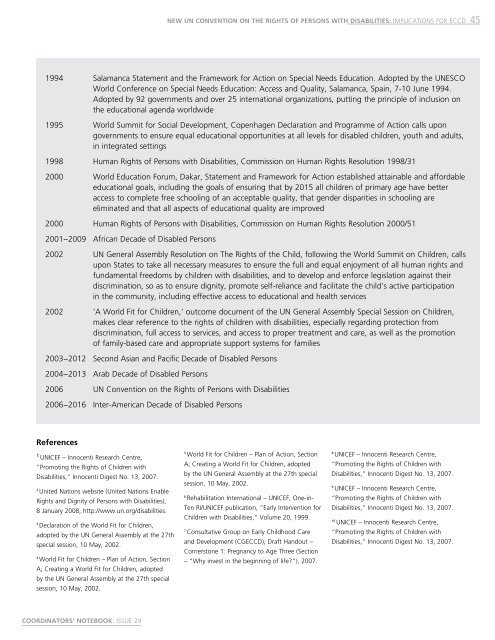A global call to action for early childhood
A global call to action for early childhood
A global call to action for early childhood
You also want an ePaper? Increase the reach of your titles
YUMPU automatically turns print PDFs into web optimized ePapers that Google loves.
New UN Convention on the Rights of Persons with Disabilities: Implications <strong>for</strong> ECCD<br />
45<br />
1994 Salamanca Statement and the Framework <strong>for</strong> Action on Special Needs Education. Adopted by the UNESCO<br />
World Conference on Special Needs Education: Access and Quality, Salamanca, Spain, 7-10 June 1994.<br />
Adopted by 92 governments and over 25 international organizations, putting the principle of inclusion on<br />
the educational agenda worldwide<br />
1995 World Summit <strong>for</strong> Social Development, Copenhagen Declaration and Programme of Action <strong>call</strong>s upon<br />
governments <strong>to</strong> ensure equal educational opportunities at all levels <strong>for</strong> disabled children, youth and adults,<br />
in integrated settings<br />
1998 Human Rights of Persons with Disabilities, Commission on Human Rights Resolution 1998/31<br />
2000 World Education Forum, Dakar, Statement and Framework <strong>for</strong> Action established attainable and af<strong>for</strong>dable<br />
educational goals, including the goals of ensuring that by 2015 all children of primary age have better<br />
access <strong>to</strong> complete free schooling of an acceptable quality, that gender disparities in schooling are<br />
eliminated and that all aspects of educational quality are improved<br />
2000 Human Rights of Persons with Disabilities, Commission on Human Rights Resolution 2000/51<br />
2001−2009 African Decade of Disabled Persons<br />
2002 UN General Assembly Resolution on The Rights of the Child, following the World Summit on Children, <strong>call</strong>s<br />
upon States <strong>to</strong> take all necessary measures <strong>to</strong> ensure the full and equal enjoyment of all human rights and<br />
fundamental freedoms by children with disabilities, and <strong>to</strong> develop and en<strong>for</strong>ce legislation against their<br />
discrimination, so as <strong>to</strong> ensure dignity, promote self-reliance and facilitate the child’s active participation<br />
in the community, including effective access <strong>to</strong> educational and health services<br />
2002 ’A World Fit <strong>for</strong> Children,’ outcome document of the UN General Assembly Special Session on Children,<br />
makes clear reference <strong>to</strong> the rights of children with disabilities, especially regarding protection from<br />
discrimination, full access <strong>to</strong> services, and access <strong>to</strong> proper treatment and care, as well as the promotion<br />
of family-based care and appropriate support systems <strong>for</strong> families<br />
2003−2012 Second Asian and Pacific Decade of Disabled Persons<br />
2004−2013 Arab Decade of Disabled Persons<br />
2006 UN Convention on the Rights of Persons with Disabilities<br />
2006−2016 Inter-American Decade of Disabled Persons<br />
References<br />
1 UNICEF – Innocenti Research Centre,<br />
“Promoting the Rights of Children with<br />
Disabilities,” Innocenti Digest No. 13, 2007.<br />
2<br />
United Nations website (United Nations Enable<br />
Rights and Dignity of Persons with Disabilities),<br />
8 January 2008, http://www.un.org/disabilities.<br />
3<br />
Declaration of the World Fit <strong>for</strong> Children,<br />
adopted by the UN General Assembly at the 27th<br />
special session, 10 May, 2002.<br />
4<br />
World Fit <strong>for</strong> Children – Plan of Action, Section<br />
A; Creating a World Fit <strong>for</strong> Children, adopted<br />
by the UN General Assembly at the 27th special<br />
session, 10 May, 2002.<br />
5<br />
World Fit <strong>for</strong> Children – Plan of Action, Section<br />
A; Creating a World Fit <strong>for</strong> Children, adopted<br />
by the UN General Assembly at the 27th special<br />
session, 10 May, 2002.<br />
6<br />
Rehabilitation International – UNICEF, One-in-<br />
Ten RI/UNICEF publication, “Early Intervention <strong>for</strong><br />
Children with Disabilities,” Volume 20, 1999.<br />
7<br />
Consultative Group on Early Childhood Care<br />
and Development (CGECCD), Draft Handout –<br />
Corners<strong>to</strong>ne 1: Pregnancy <strong>to</strong> Age Three (Section<br />
– “Why invest in the beginning of life?”), 2007.<br />
8<br />
UNICEF – Innocenti Research Centre,<br />
“Promoting the Rights of Children with<br />
Disabilities,” Innocenti Digest No. 13, 2007.<br />
9<br />
UNICEF – Innocenti Research Centre,<br />
“Promoting the Rights of Children with<br />
Disabilities,” Innocenti Digest No. 13, 2007.<br />
10<br />
UNICEF – Innocenti Research Centre,<br />
“Promoting the Rights of Children with<br />
Disabilities,” Innocenti Digest No. 13, 2007.<br />
COORDINATORS’ NOTEBOOK: ISSUE 29
















